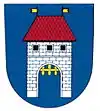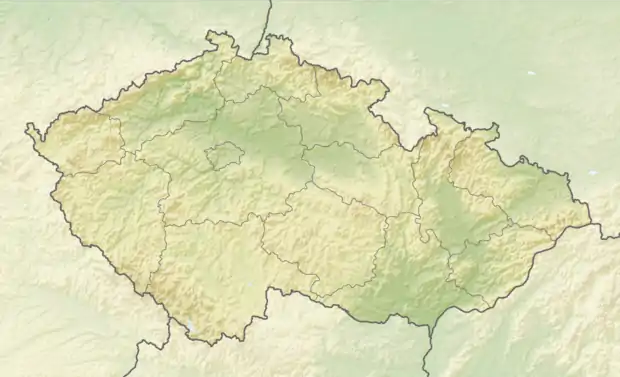Škvorec
Škvorec is a market town in the Prague-East District in the Central Bohemian Region of the Czech Republic. It has about 1,900 inhabitants. Part of the townlet is also Třebohostice village.
Škvorec | |
|---|---|
 Main square | |
 Flag  Coat of arms | |
 Škvorec Location in the Czech Republic | |
| Coordinates: 50°2′49″N 14°43′50″E | |
| Country | |
| Region | Central Bohemian |
| District | Prague-East |
| First mentioned | 1279 |
| Area | |
| • Total | 12.74 km2 (4.92 sq mi) |
| Elevation | 305 m (1,001 ft) |
| Population (2020-01-01[1]) | |
| • Total | 1,909 |
| • Density | 150/km2 (390/sq mi) |
| Time zone | UTC+1 (CET) |
| • Summer (DST) | UTC+2 (CEST) |
| Postal code | 250 83 |
| Website | www |
History

Škvorec Castle is first mentioned in historical sources in 1279[2] (but more fully documented in 1404). The founder, and maybe the builder too, was probably Domaslav around 1279, an important courtier and landed official, the butler of the Queen (1262) and her food taster (1263–1269, 1279), Lord High Treasurer (1267–1278) and one of the ten Burgraves of the Prague Castle. From the castle he built, only the deep well is now preserved, cut in the granite rock, which was situated near to the early gothic palace – that standing on the site of the present school building.
The coat-of-arms of Domaslav of Škvorec (three vertical stripes), which cannot be found later in the Central Bohemia, proving that the castle must have passed to another noble family not long after . But unluckily the names of the owners until after 1450 are today not known.
In the second half of the 14th century, the castle was owned by the Olbramovic family of Prague. One of them, Olbram son of Menhart (died around 1388), installed the priest of the church in Horky, which already belonged to Škvorec by 1354. Olbram son of Menhart was from 1356 the Reeve of Prague New Town and in 1373–1380 the Burgrave of Vyšehrad. In connection with Škvorec he is mentioned only two times: first as Olbram of Škvorec (in Skworzecz) in the records of visitation of the Prague archdeacon Pavel of Janovice from 1380, and as Olbram son of Menhart of Škvorec a document from 1385 (de Skworecz).
After his death, his three sons Olbram, Pavel and Václav became the owners of Škvorec. The most important of them was Olbram: in 1377 he started to study at the Faculty of Law of Prague University. In 1379 he became the canon of Prague and Vyšehrad. Between 1389–1396 he was the provost of St. Apolinar in Prague New Town, and also the chancellor of the king's brother Jan of Zhořelec. On 31 January 1396, he became the Archbishop of Prague (he was installed by Pope Boniface IX.). His brother Pavel was a Burgrave in Týn nad Vltavou (1397), and Václav earned 500 marks of silver in the king's service in 1396. These successes of the three brothers had an influence on their building activity at Škvorec, because its early gothic castle did not conform to the needs of noblemen at the end of the 14th century.
According to the archeological, historical and building research made by architect Jan Žižka, it appears that round 1400 the family of Olbramovic essentially enlarged the area of the castle and added to the buildings. Opposite the old early-gothic palace they built an oblong tower with a pointed-arched gate and with a small wicket, together with drawbridges across the newly dug water-filled moat. Above it, east of the entrance tower, they built another gothic palace with a chapel, whose chaplain called Václav is noted in judgment roll of the Archbishopric of Prague in 1404. Due to the building of the new palace, Škvorec thus had two palaces, as was faithfully recorded in the fideicommissum documents in 1654.
The archbishop with his two brothers owned Škvorec castle until 2 May 1402, when he died. His two surviving brothers then divided the property amongst themselves. Next, Jan Nichilen of Prague bought the Václav's share (the rent from Škvorec Castle, half of the farmyard and some villages) in 1411, and before 1418 the owner of it was Jan of Klučov. The second half of property was still owned by Pavel of Škvorec until his death (after 1418).
His widow Eliška (Elisabeth) married before 1422 Jan Ohnništko of Ohnišťany, who appropriated the second half of the property too. But in 1426 he violated the parliamentary peace, when he killed his ex-neighbor Prokop Trčka of Květnice in a duel in Prague. As a result, he was brought to court and then executed. Eliška became a widow again and very soon she had big debts. Because of them, she had to sell the rent from Škvorec, Hostyň and the half of the market town of Úvaly to Prokop Bervík of Malešice in the same year. But he sold it only a short time after to Vilém of Kounic, from whom it was bought by Petřík Olbrámovic (shortly called Olbrámek), and thanks to this the whole property was again owned by the family of Olbramovic of Prague.
The next important owner of Škvorec castle was Čeněk of Klinštejn the Crown Prosecutor, who bought it from the Olbramovic family in 1462. He was a very significant person in the Bohemia of that time. He was not only the Crown Prosecutor, but also a Burgrave of Prague Castle (1451–1461) and of Vyšehrad (1467–1479) and in the years 1457–1481 he was the Queen's Prosecutor. In the time of his son Jan, in 1497, King Vladislav II of Bohemia made Škvorec into a market town. After his death round 1509, his brother Zdeněk inherited the Castle. He had many lawsuits with his neighbours, townsmen and also with his nearest relatives, as did his son Jindřich, who died in the battles against the Turks in Hungary. After that, the Castle passed to brother of Jindřich's mother – Zikmund Smiřický of Smiřice. In about 1545 he started reconstructing the old castle and modernised it into a renaissance seat. During this reconstruction he probably built the western range with arcades and the building on the eastern side of the courtyard.
During the inheritance procedure after his death, his sons divided the large family property so that Jaroslav became the owner of Škvorec, Albrecht received Náchod and Miletín and Jindřich got Hrubá Skála and Hořice. But not much earlier than 1560, Albrecht is also mentioned as the owner of Škvorec. His son Václav Jaroslav spent a long time in Škvorec, where he died in 1593. His son, Albrecht Václav, died in 1614 and the Castle was inherited by his uncle, Albrecht Jan.
As the fideicommissum records from 1618 tell, Albrecht Jan Smiřický of Smiřice had a vaulted hall known as "the stone hall", lord's apartment and also an armoury in the Castle. In other parts of the Castle there were the offices and rooms of members of his estate government and on the ground floor there was some economic establishment.
During the confiscation of his property in 1621 Škvorec Castle fell into the hands of Albrecht of Valdštejn, because his mother was from the Smiřický family. He sold it to Karel of Liechtenstein in 1623.
In the second half of the 17th century Jan Adam of Liechtenstein ordered his officials Šimon Karel Svoboda and Jan Kašpar Ouvalský to elaborate the urbarium of his domain. So in 1677 The Golden Book (Zlatá kniha,), which was written in Czech, was finished.
The preserved records of the 'hejtman' of Černý Kostelec, Captain Přech Svatkovský of Dobrohošť, shows that the Swedes plundered the Castle and set it on fire on 27 November 1639. During the fire the ceilings in some rooms in both palaces collapsed (in one of them – in the upper palace – was the jail for the retainers in that time). The repair works appear to have been minimal: until 1654 only the upper palace was covered by a temporary thatched roof and no more reconstruction then continued. So for the rest of the 17th century the Castle was known as a ruin.
From the records of the Uhříněves Estate (to which Škvorec belonged at that time) it is known that the first part of the Castle was repaired by Kristian Minedi in 1710, when he submitted accounts for repairing six rooms to the Estate government. This northern part of the Castle became the seat of Princess Maria Theresa of Savoy, born of Liechtenstein (died 1772) after 1729. Škvorec Castle was still habitable in 1794, but in the years that followed it started to decay again. Instead of reconstruction, the Castle was largely dismantled in 1860–1884.
The dilapidated north-western range of the old Castle was demolished first, then the western two-storied wing was taken down in 1883. On the site of the ruin of the old gothic palace, the local school was built in 1890. Of the whole castle only the rebuilt baroque south-eastern part with the gatehouse tower was left – and also the old Castle well in the courtyard. The so-called 'New Castle' stands opposite the old one. It comprises a large baroque one-storey building with a courtyard of farm buildings, the remains of an old fountain and a baroque gate. As the plans of the architect Josef Jägr from the Liechtenstein family archive in Vaduz testify, this new part of Škvorec Castle was built soon after 1791.
References
- "Population of Municipalities – 1 January 2020". Czech Statistical Office. 30 April 2020.
- "Škvorec" (in Czech). Hrady.cz. 17 July 2008. Retrieved 17 October 2008.
| Wikimedia Commons has media related to Škvorec. |
